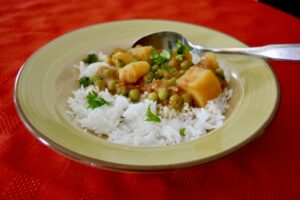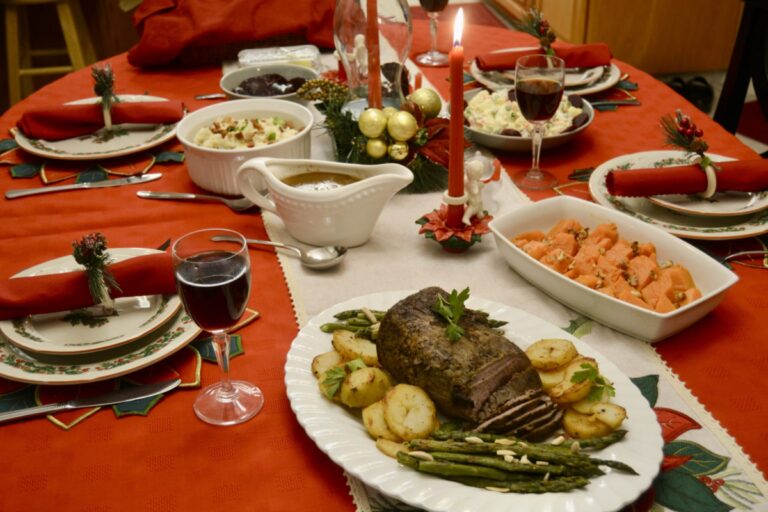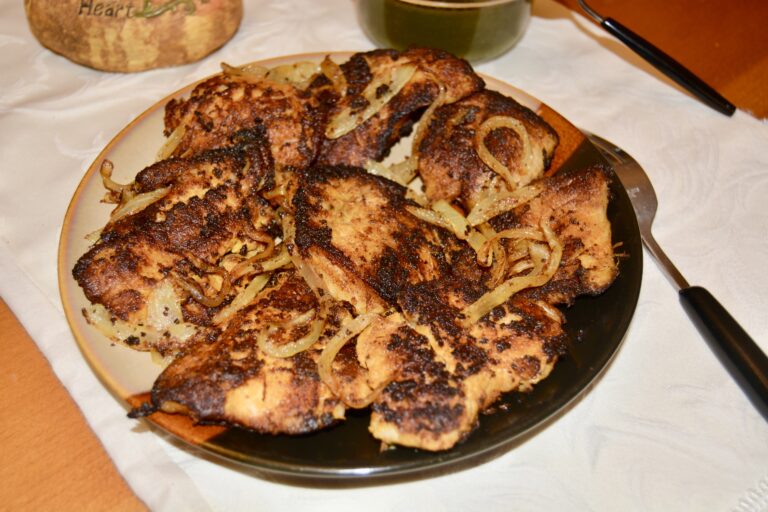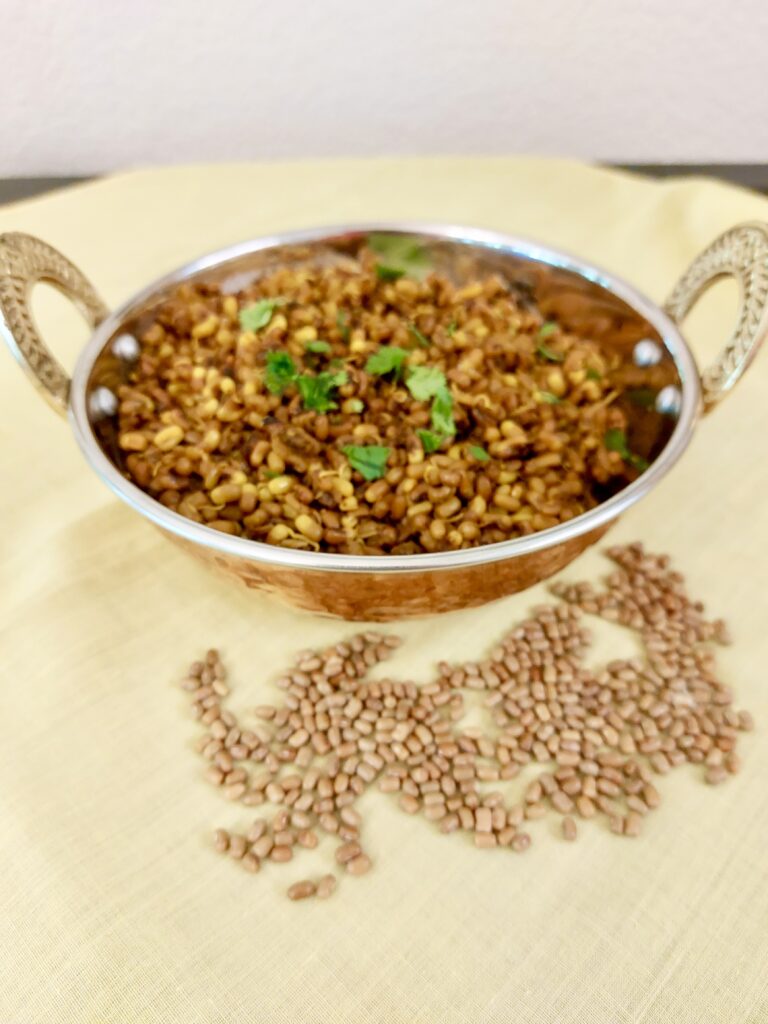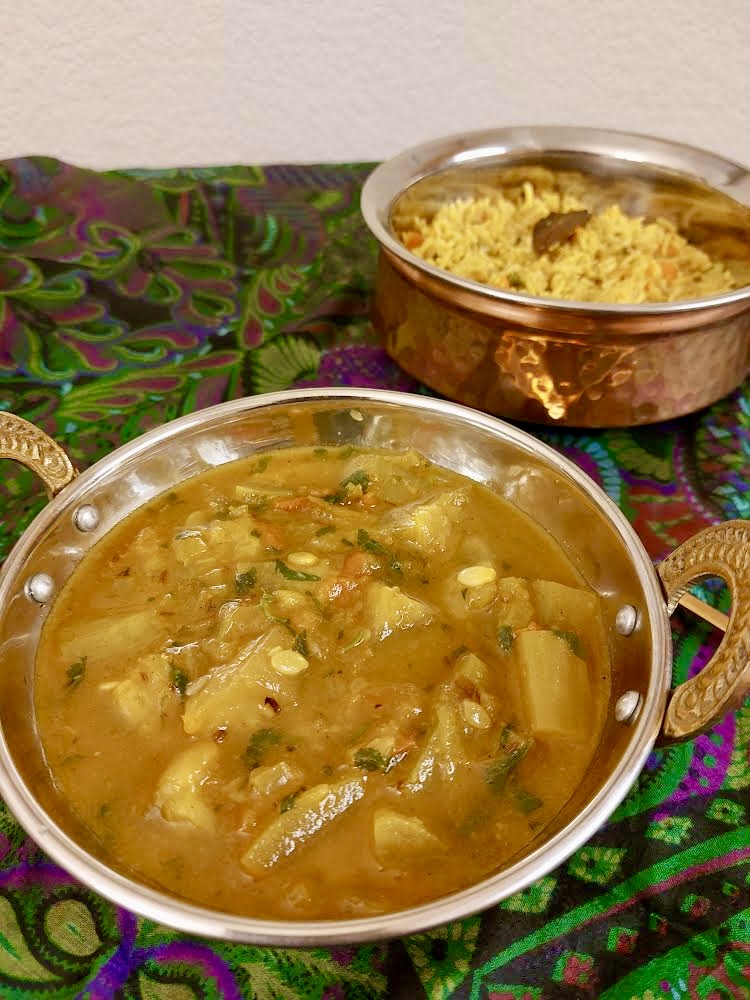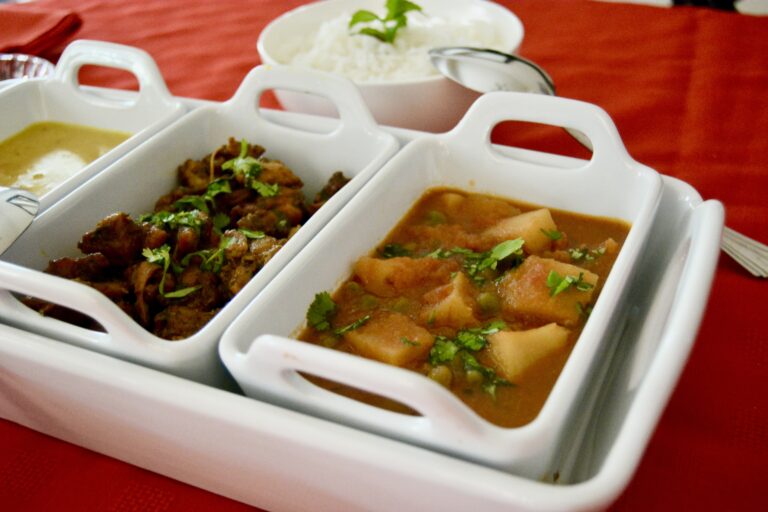I am at the grocery store trying to pick out a cut of beef for a roast. I have fixed various kinds of roast, but I spot a cut called an eye of round roast beef that I have never cooked. I decided to try it using Mama’s recipe for a leg of meat she would fix for Christmas when we were in India. Most feast days were elaborate Indian meals, but for Christmas and Easter, Mama went Western in our house. She would hand-pick the leg of goat or lamb meat and then supervise the cook in preparing it.
The meat was slow-cooked on the stovetop until done. I recall one Christmas, our cook had just finished fixing the roast and brought it to the dining table to rest. A few minutes later, our pet, an Alsatian named Sally, was drawn by the smell of the roast. With her front paws up on the table, she was big and nimble enough to grab the leg of meat and bring it to the floor. Cook heard the crash and came running but was too late. Sally had decided what she would like for dinner! Fortunately, there was enough time to fix a couple of chicken roasts, so dinner was not a disaster.
For a chicken roast, try our Tandoori Chicken Roast.
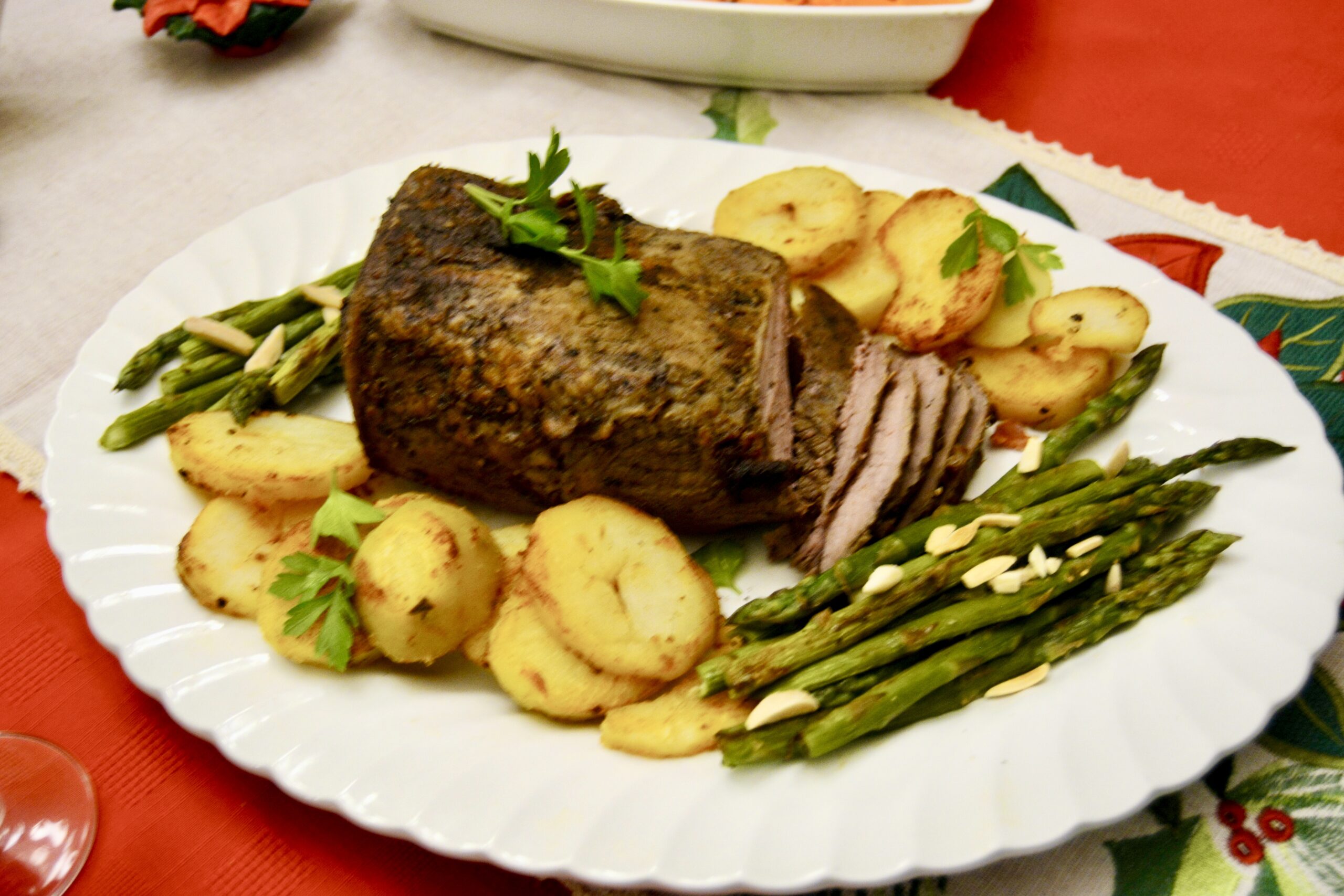
Christmas Roast
Ingredients
- 2.7 lbs eye of round roast (or any cut of beef your prefer)
- 1 tbsp cooking oil (for rub)
- 1 large black cardamom (optional)
- 1 tbsp cracked pepper
- 1½ tbsp kosher salt
- 3 tbsp Worcestershire Sauce
- 2 tbsp cooking oil
- 1 one-inch cinnamon stick
- 2 Bay leaves
- 8 whole cloves
Instructions
- Mix the oil, cracked pepper, salt, and Worcestershire sauce in a small bowl.
- Place the roast in the bowl and rub the roast with the mixture. Let the roast rest in the bowl for half an hour to bring it to room temperature.
- Keep a roasting rack and pan ready. Brush lightly with oil.
- Turn the oven on and set the temperature to 325 degrees F.
- Heat 2 tablespoons of oil on a medium heat using a heavy-bottomed pot or skillet.
- Add the black cardamom, cinnamon, bay leaves, and cloves. Let sizzle for 30 seconds.
- Now add the roast and sear it on all sides, turning carefully with pair of tongs. Let each side brown nicely for 2-3 minutes. Continue to do this until all the sides are nicely browned—approximately 15 minutes. Turn off the heat.
- Transfer the roast to the baking pan but save the skillet drippings for the gravy.
- Add about 1 cup of beef broth to the baking pan to keep the roast moist and prevent its juices from burning.
- Cover the lightly with foil and bake the roast for 1/2 hour covered.
- Uncover and bake for approximately another hour or less until done to your preference. Our family prefers it well-done.
- Remove from the oven, and cover the roast loosely with foil.
- Let it rest for 30-40 minutes before slicing. This will help the juices inside the roast to redistribute themselves without being lost while cutting.
- Transfer to a serving platter and circle roast with vegetables of your choice.
- I use steamed and lightly sautéed peppered asparagus (or long green beans) and boiled fried potatoes. You could also use steak-fried potatoes.
Notes
Mom would never cook fish in the months with no R in it. So the months of May, June, July, and August were fishless months for us. She maintained that those were the monsoon months, and all the impurities from the land surface were washed by the torrential rain into the rivers, ponds, and lakes. This did not apply to deep sea fish, but since we did not get much of those in the areas we lived, she refused to buy any other fish.
I don’t know if that was true, but I never cooked fish during those months while in India. Now here in the USA, I buy frozen packs of fish from Costco so don’t hesitate to cook fish whenever I want.
Fish can be fixed in several different ways. One of the quick and easy ways to fix fish is Tandoori style. This can be grilled, pan fried, baked, or done in the air fryer. I prefer mine pan fried.
This is a tangy spicy fish dish coated with flavorful tandoori masala.
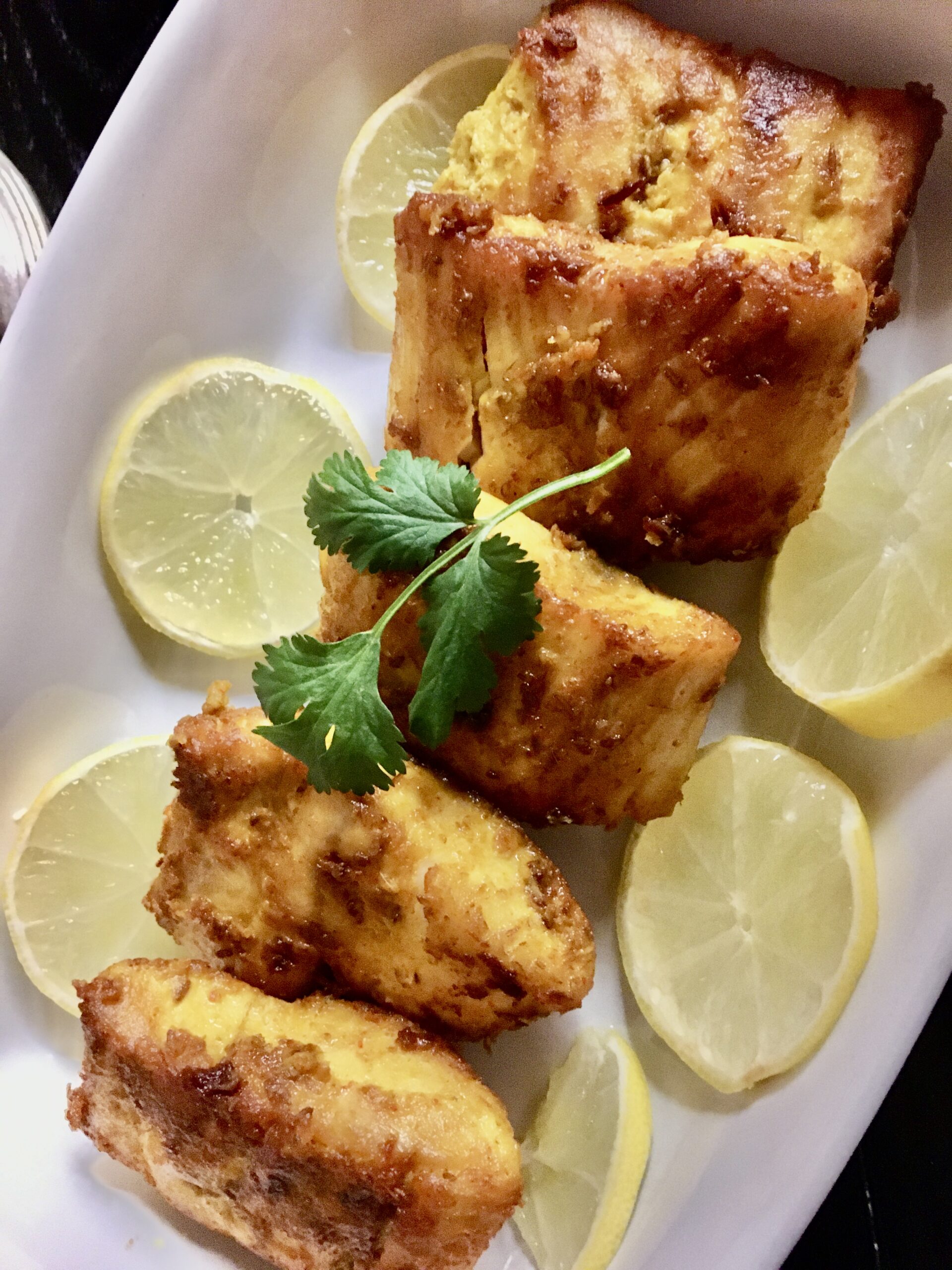
Tandoori Machi (Tandoori Fish Fry)
Ingredients
- 2-3 lbs boneless firm or semi-firm white fish (mahi mahi, cod, haddock, flounder, tilapia)
- 2 Tbsp thick plain "hung" yogurt (see note)
- 1 Tbsp garlic-ginger paste
- ½ tsp chili powder or Kashmiri red chili powder (see note)
- 1 tsp coriander powder
- 1 tsp cumin powder
- 1 tsp turmeric powder
- ¼ tsp black pepper powder
- ½ tsp garam masala
- 1 tsp salt
- 1 tsp lemon juice
- 3 Tbsp cooking oil (for frying)
Garnish
- 1 medium yellow or red onion (sliced fine)
- 1 Tbsp fresh cilantro/green coriander leaves (chopped)
- ½ tsp chaat masala (from an Indian grocery store—optional)
- 1 lime/lemon (cut into wedges or slices)
Instructions
To Prepare
- If you are using frozen fish, be sure to defrost them overnight. Rinse the fish fillets and pat them dry. Slice them into thick two-inch slices. If they are thin fillets, leave them whole or cut them in half.
To Marinade
- In a bowl, mix the yogurt, ginger-garlic paste, salt, lemon juice, and spice powders, including a tablespoon of cooking oil. Blend well.
- Place your sliced fish into the bowl and gently rub the paste all over the fish pieces until nicely coated. (I use food-handling plastic gloves to keep the fish smell off my hands!).
- Cover the bowl with plastic wrap and keep in the refrigerator for at least 20-30 minutes.
To Cook
- Remove the fish from the refrigerator.
- Heat the remaining 2 tablespoons of oil in a high-rimmed skillet or frying pan over medium-high heat.
- Remove each piece of fish from the bowl, ensuring it is nicely coated with the marinade.
- Place in the hot oil one at a time. Do not overcrowd. You can fix it in batches.
- Save any remaining leftover marinade and add the onions to them. There should be very little marinade but enough for a light coating. You can even use them without the marinade.
- Fry the fish on each side for 3-4 minutes until golden.
- Place the fried fish on a paper towel to drain.
- Add the sliced marinated onions to the hot pan. There should be enough oil to lightly sauté the onions until they are translucent. Drain on a paper towel.
- Serve fish on a platter.
- Sprinkle some chaat masala over the fish (optional).
- Garnish with the sautéed onions. You can also use raw onions or garnish with lemon slices and cilantro. Any chutney will pair well with it.
- Serve with naan or any kind of flat bread. It goes well with a rice pilaf.
Notes

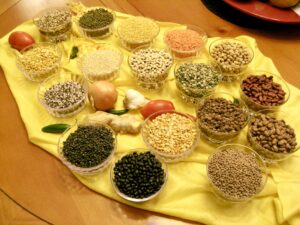 Dals are an integral part of an Indian meal, and we have a variety of them. With the abundance of dals and the many ways to season them, we could have a different dal every day of the month and not repeat a recipe!
Dals are an integral part of an Indian meal, and we have a variety of them. With the abundance of dals and the many ways to season them, we could have a different dal every day of the month and not repeat a recipe!
One of my favorites is a small brownish bean, rather like a whole green moong bean, called moth (pronounced moat) or matki. These lentils are highly nutritious and can be prepared in a variety of ways.
This particular recipe uses sprouted moth beans. It makes a great anytime snack or a side dish to a meal. Sprouted beans can also be used in salads.
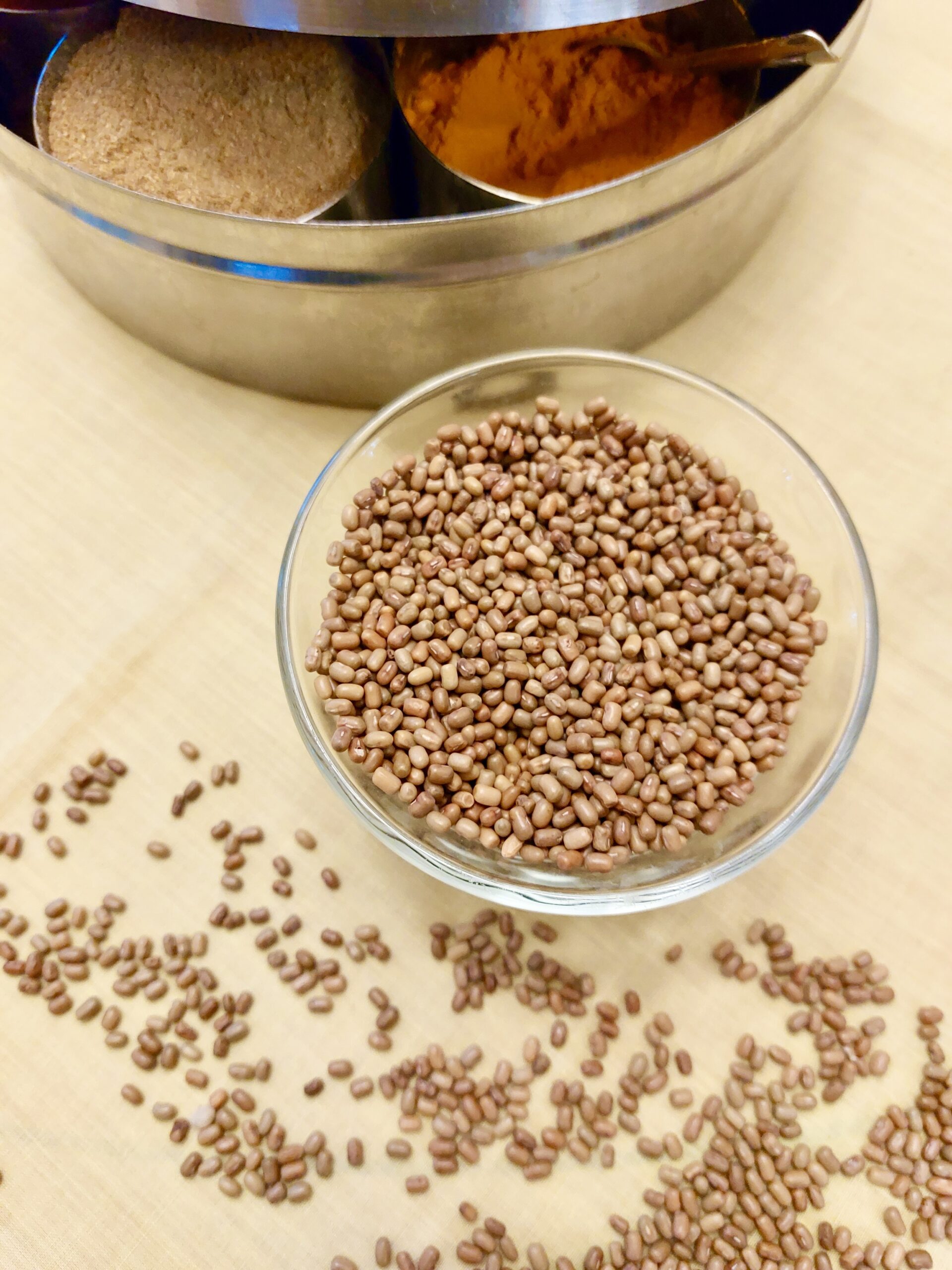
Moth/Matki Sukha Sabzi (Sauteed Moth Bean)
Ingredients
- 1 cup moth beans
- 1 medium yellow or red onion (chopped)
- 1 tsp cumin powder
- 1 tsp turmeric powder
- ¼ tsp red chili powder (or to taste)
- ⅛ tsp garam masala
- ½ tsp amchur powder (or 1 Tbsp lemon juice)
- 1 tsp salt
- 2 Tbsp cooking oil
- 1 Tbsp fresh chopped cilantro (coriander leaves) (for garnish)
Instructions
To Prepare the Dal
- Sort the moth beans clean of any grit.
- Pour into a medium bowl or pot. Wash the moth about 4 times, rubbing the beans gently between your fingers.
- Add 4-5 cups of water. It should be enough to cover the beans by about 2 inches. Leave to soak overnight or for at least 4 hours. Strain the moat and wrap them in a moist muslin/cheesecloth. A clean kitchen cloth will also do.
- Now, put the wrapped beans into the bowl or pot. Sprinkle water over them, cover them, and let them sit for two days. Be sure the cloth is kept moist so that the moth can sprout.
- After two days, they should be sprouted. Not all of them will sprout sometimes, but that is fine. If half are still not sprouted, leave them for another day to continue sprouting.
To Cook
- Lightly rinse the beans and set aside.
- Peel and dice onions reasonably small. About ¾ cup is good.
- Place a medium pan or skillet on medium heat. Heat 2 tablespoons of oil in the pan.
- Add the chopped onion.
- Sauté for 4-5 minutes until translucent and the edges start to turn golden.
- Now add all the powdered spices and salt. Sauté for 30 seconds. Don't let the spices burn.
- Add the sprouted moth beans. Stir gently so the beans are coated with the spices.
- Add ¾ cup of warm or hot water.
- Cover the pan with a lid, lower the heat to medium-low, and let simmer for about 20 minutes, stirring occasionally, until the beans are soft but not mushy.
- Sprinkle with lemon juice or amchur powder and gently stir the dal.
- Pour into a serving bowl and garnish with the chipped cilantro.
Notes
If you have a bean sprouter, you can use that to sprout the moth.
This recipe is morphed from Mama’s Biryani recipe. Sometimes, I would serve Vegetarian Biryani instead of Biryani with meat or chicken. This saved me the hassle of fixing two types of pilafs for a lunch or dinner party. I would pair it with channa dal, two different styles of sabzis (Indian sauteed vegetables), a paneer curry, and a non-vegetarian dish. Along with that came the usual array of pickles, raita, and rotis. It made quite a meal!
There is a less elaborate Vegetarian Pilaf, which I shall share as well.
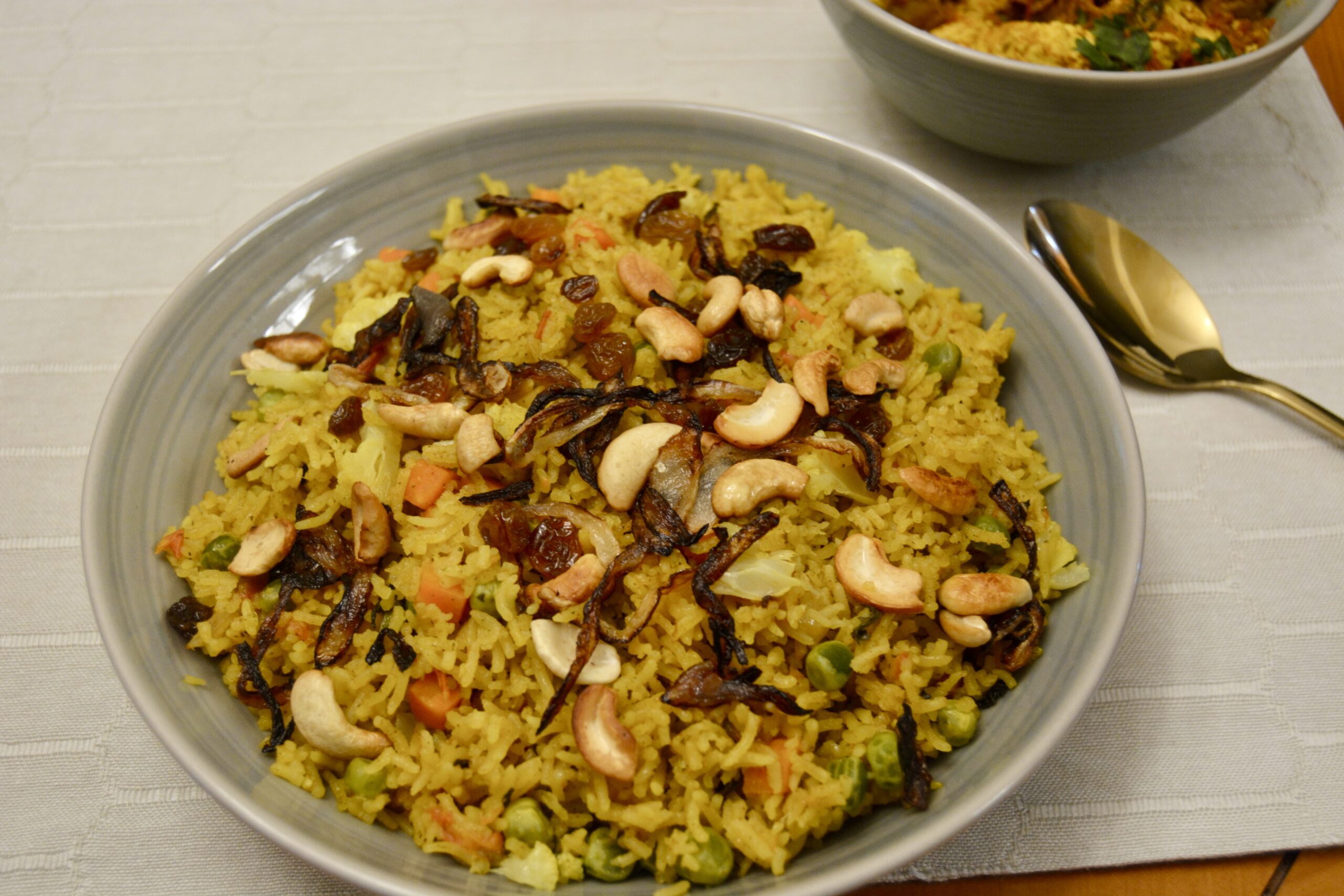
Vegetable Biriyani
Ingredients
- 5 cups Basmati rice
- ½ cup oil (plus a little extra, if needed)
- 2 Bay leaves
- 4 cinnamon sticks (or ½ tsp cinnamon powder)
- 1 large black cardamom
- 6 small green cardamoms
- 6 cloves (or ¼ teaspoon clove powder)
- 3 large onions (peeled, cut in half, and sliced thin)
- 2 medium Serrano chilies (washed, remove stem, and slice in half)
- 3 tbsp ginger paste (freshly ground is best, but ready-made is fine, too)
- 2 tbsp garlic paste (freshly ground is best, but ready-made is fine, too)
- ½ cup fresh green coriander ground fine (mainly leaves, but a portion of stem is okay)
- 3 tbsp coriander powder
- 1 tsp turmeric powder
- 1 tsp red chili powder (or to your taste—remember this and the green chilies will add heat to the pilaf)
- 6 medium tomatoes (finely chopped or puréed)
- 1 tbsp poppy seeds ground smooth (optional)
- 1 can coconut milk (or the fleshy, white part of 1 fresh coconut ground smooth with the poppy seed)
- 8 cups water (plus a little extra)
- 2 cups peas and diced carrots (you may combine it with other vegetables such as cauliflower, cut into flowerets, or diced beans)
- 2 tbsp mint leaves (finely chopped)
- 2 tbsp chopped fresh green coriander leaves
- Salt (to taste)
- 2 limes (juice only)
Garnish
- ½ onion (or use pre-fried store-bought onions to make it easy)
- sautéed cashews (or use cocktail cashews)
- sautéed raisins
Instructions
To Prepare
- Gather all the ingredients before you start.
- Wash and soak the 5 cups of rice for 15-20 minutes. Drain and set aside.
- Mix coconut milk, ground poppy seed(optional), and 8 cups water.
- Together they should measure 10 cups plus 2 tablespoons of liquid.
- Combine chopped mint leaves and coriander leaves with the juice of 2 limes in a small bowl.
To Cook
- Heat ½ cup of oil in an 8-quart heavy-bottomed pot on medium heat. You may need a tablespoon or two extra as you start to sautée.
- Add the whole Bay leaf cinnamon, cardamom, and cloves.
- Add cut onions and slit green chilies.
- When half-fried (about 6 minutes), add the ground ginger, garlic, spice powders (including the ground cinnamon and cloves, in case you decided to use them instead of the whole ones), and green coriander paste.
- Fry for about 3-4 minutes until fragrant, then add the chopped and pureed tomatoes. Sauté for another 5 minutes.
- Now add the drained rice and sauté on medium heat, stirring carefully to not break up the rice grains. About 2-3 minutes.
- Pour in the water, coconut milk, and salt. Cover and bring to a boil.
- Once the water starts to boil (10-15 minutes), add the vegetables and cook on medium-low until the water is almost evaporated and you see little pits on top of the rice.
- Stir gently. Sprinkle the chopped mint, coriander, and lemon mix over the rice.
- Put on low and cook another 10 minutes until the pits disappear on top and the rice is cooked. You can test by testing a grain between your thumb and forefinger. If it's grainy, let it cook for a little more, but make sure the underside is not getting burnt.
- Fluff with a fork and plate on a rice platter or serving dish.
- Garnish with sauteéd onions, cashews, and raisins.
Notes
I am standing in my mother-in-law’s kitchen with my hair up in a knot and my kaftan hitched up to my knees. It is summer and the monsoons are in full swing. The humidity makes me hot and sweaty, but I am the sous-chef for the day and dare not leave my post!
Since Mummy is on her own, she does not believe in keeping a cook and prefers to do everything herself, except for a domestic helper for sweeping, swabbing, and general help around the house.
I wash and peel the bottle gourd, cut it up into bite size bits, and then peel and chop the onions. Once the cilantro has been cleaned, we get started.
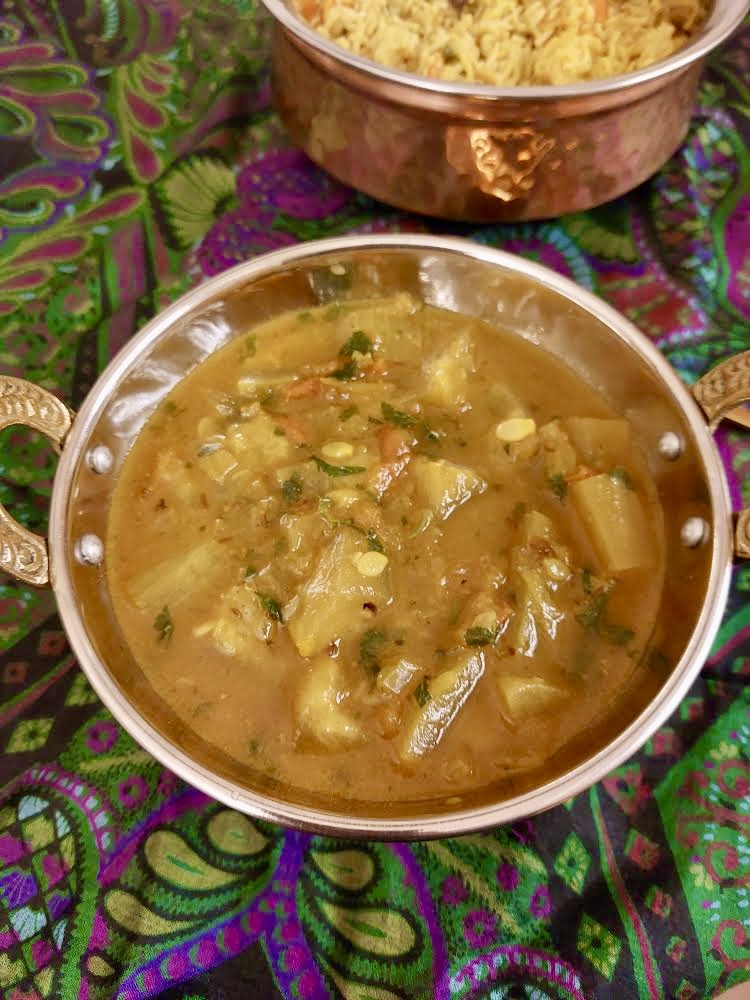
Lauki Curry (Opo Squash Curry)
Ingredients
- 1 medium lauki/opo squash
- 1 medium onion (finely diced)
- 1 large tomato (chopped finely)
- 1 small dry red chili (or a fresh green Serrano chili, to taste)
- 2 Tbsp ginger-garlic paste
- 1 tsp turmeric
- ¼ tsp red chili powder
- ½ tsp cumin seeds
- 1 tsp salt
- 3-4 cups water
- 1 Tbsp chopped cilantro (for garnish)
Instructions
- To prep your squash, wash it, and then cut both ends and peel the skin off with a vegetable peeler.
- Slice the peeled squash in half. You can remove the seeds and any squishy pulp if these seeds are too large (as in older squash).
- Now slice each half lengthwise, then across to form bite-sized cubes.
- Heat oil over medium heat in a deep skillet or stock pot (need a lid).
- Add the red/green chili until it turns dark, for about 30 seconds.
- Add the cumin seeds, let them sizzle, and immediately add the finely diced onion. Do this quickly so that the cumin seeds don't burn.
- Sauté the onions until they are medium brown (5-7 minutes).
- Add the ginger-garlic paste along with the turmeric and chili powder. Stir.
- Now sauté the mixture for about a minute or so, until you feel the ginger-garlic paste sticking to the bottom of the pan.
- Add the chopped tomato. Continue to sautée for another 5-7 minutes until the tomatoes are well cooked and mushy.
- Add the squash, stir, and sauté for approximately 2 minutes until the squash is nicely coated with the onion-tomato mixture (masala).
- Add the water and salt. Stir, cover, and cook for about 20 minutes until the squash is fork-tender.
- Pour into a serving dish and garnish with chopped cilantro.
- Serve with boiled white or brown rice, roti, or as a side to a meal.
Notes
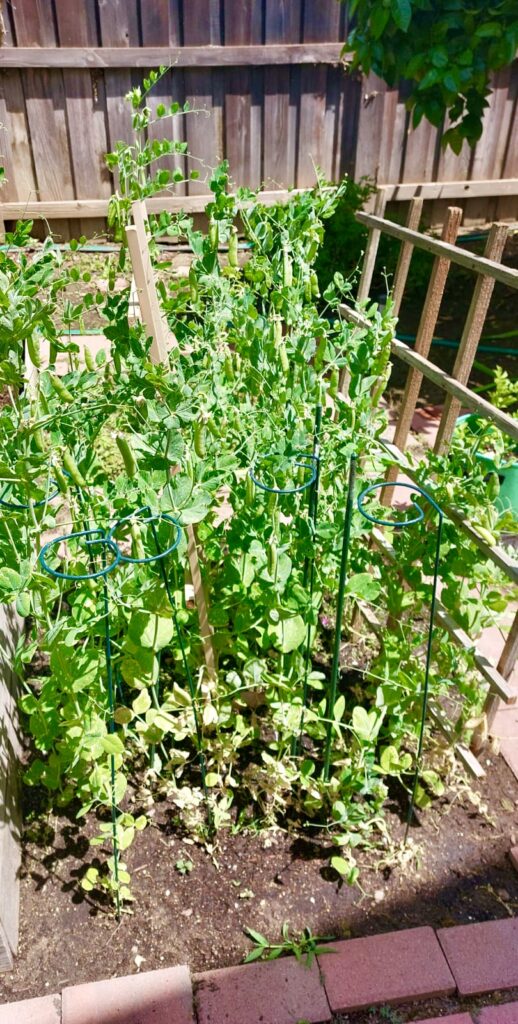 The morning is beginning to heat up. I look out my kitchen window at the small patch of peas I am growing. It needs a weeding. Armed with my garden hat, gloves, and shovel, I head out to see if I can tackle the weeds before it gets too hot. I am pleased to see that there are enough peas I can pick to fix a curry or sabzi (sautéed vegetable of any kind without gravy). A little while later, I return to the kitchen with fresh peas.
The morning is beginning to heat up. I look out my kitchen window at the small patch of peas I am growing. It needs a weeding. Armed with my garden hat, gloves, and shovel, I head out to see if I can tackle the weeds before it gets too hot. I am pleased to see that there are enough peas I can pick to fix a curry or sabzi (sautéed vegetable of any kind without gravy). A little while later, I return to the kitchen with fresh peas.
 I recall walking through the sabzi mandi’s (vegetable markets) in India or stopping by the wayside vegetable vendors’ stalls by the primary market. The vegetables were always farm fresh. You would make your selection. The grocer would weigh these on scales and put them into the ‘thaila’ (cloth bag) you carried with you—before plastic bags hit the scene! Of course, there was always bargaining to be done. It was an essential part of the buying process. I didn’t bargain much, knowing how hard they worked to make a living, so I always caved. I never quite got used to it!
I recall walking through the sabzi mandi’s (vegetable markets) in India or stopping by the wayside vegetable vendors’ stalls by the primary market. The vegetables were always farm fresh. You would make your selection. The grocer would weigh these on scales and put them into the ‘thaila’ (cloth bag) you carried with you—before plastic bags hit the scene! Of course, there was always bargaining to be done. It was an essential part of the buying process. I didn’t bargain much, knowing how hard they worked to make a living, so I always caved. I never quite got used to it!
Taridar Mattar Allu is a vegetarian, North Indian dish that is delicious with dals, rice, and rotis!

Taridar Mattar Allu (Peas and Potato Curry)
Ingredients
- 1 cup fresh or frozen peas
- 3 medium potatoes
- 2 bay leaves
- 1 stick cinnamon (1 inch stick)
- 2 green cardamoms
- 4 peppercorns
- 4 cloves
- 1 medium Serano chili, slit (to taste, or optional )
- ¾ cup yellow onion (diced finely)
- 1 tbsp ginger-garlic (paste)
- ¼ tsp turmeric powder
- ¼ tsp cayenne pepper (to taste, or optional)
- 1 tsp cumin powder
- 2 tsp coriander powder
- 2 medium tomatoes
- 3 tbsp cooking oil
- 1 tsp salt (or to taste)
- 3 cups water
- 2 tbsp fresh cilantro (coriander leaves) (chopped finely)
Instructions
- Scrub, peel, and quarter the potatoes. Place them in a bowl of water so that they don't brown.
- Heat your oil in a heavy-bottomed pan on medium heat.
- Add the bay leaves, cinnamon, cardamom, peppercorns, and cloves. Let splutter for 30 seconds, and then add the finely diced onions.
- Sauté on medium-high heat until onions turn golden—approximately 7-8 minutes.
- Add the ginger-garlic paste and sauté for 2 minutes. The ginger tends to stick at the bottom, so be sure to stir it well.
- Now add the turmeric, cayenne, cumin, and coriander powder. Sauté for a minute, stirring well.
- Now add the chopped tomatoes. Cook the tomatoes for approximately 4-5 minutes until the oil rises to the surface.
- Now add your peas and potatoes. Give it a few stirs before adding your water and salt. Stir the pot. Bring the water to a boil.
- Cover and cook on medium till the potatoes are cooked—approximately 15-20 minutes.
- Pour into a serving bowl and garnish with the chopped cilantro. Serve with boiled rice, pilaf, flat or fried Indian bread, tortillas, or pita bread.
Notes
